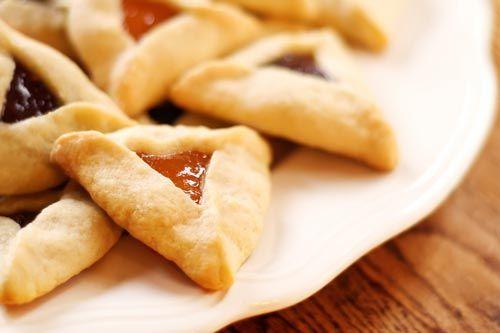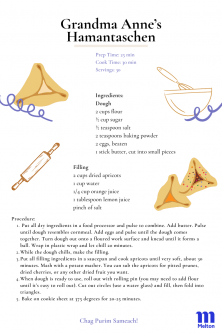Mixing Dough and Heritage in the Name of Hamantaschen
One special Purim tradition is baking hamantaschen, the three-cornered cookie often filled with poppyseed, jam, or chocolate. Bake them with us in this video with local Los Angeles hamantaschen maven Debbie Pearlman and Melton's Director of Programming and Travel Initiatives Andrea Gardenhour! Recipe and more about Debbie below.
Grandma Anne's Hamantaschen
2 cups flour
½ cup sugar
½ teaspoon salt
2 teaspoons baking powder
2 eggs, beaten
1 stick butter, cut into small pieces
Put all dry ingredients in a food processor and pulse to combine. Add butter. Pulse until dough resembles corn meal. Add eggs and pulse until dough comes together. Turn dough out onto floured work surface and knead until it forms a ball. Wrap in plastic wrap and let chill 20 minutes.
2 cups dried apricots
1 cup water
1/4 cup orange juice
1 tablespoon lemon juice
pinch of salt
Put all ingredients in a saucepan and cook apricots until very soft, about 30 minutes. Mash with potato masher. You can sub the apricots for pitted prunes, dried cherries, or any other dried fruit you want.
When dough is ready to use, roll out with rolling pin (you may need to add flour until it's easy to roll out). Cut out circles (use a water glass) and fill, then fold into triangles.
Bake on cookie sheet at 375 degrees for 20-25 minutes.
Debbie is a local Los Angeles treasure, well known for her delicious baked goods and especially her hamantaschen, which she makes and sells about 500 of each year. Here is her story.
My family hails from Rhodes by way of the Belgian Congo (now the Democratic Republic of the Congo). When my mother came to America in 1958, she met her husband, a Jew from Alabama, and the family settled in Atlanta and then Los Angeles. My mom cooked us the Sephardi dishes of her heritage – I think she wanted to feel closer to her family who was so far away. I'm so glad she fed us these memories, and those dishes are my comfort food to this day. My sister and I have made sure to learn how to make all the recipes. It seems like not too many people can make that food anymore, so we are doing our part to keep it going. So, I didn't grow up with conventional American Jewish food like kugel, gefilte fish or even hamantaschen! But my husband, Steve, is Ashkenazi, from Portland, Oregon. Both of his grandmothers were wonderful cooks, and we have integrated Steve's Ashkenazi comfort food into our Jewish holiday meals. Alongside the Sephardic burekas and keftes we have the Ashkenazi cherry-wine Jello and Shabbat chicken. The hamantaschen recipe shared here is from Steve's Grandmother Anne Pearlman. No one in the family knows its origins. They think she made it up, which wouldn't surprise me a bit. I started making the hamantaschen about 15 years ago when my kids were young. They really are the best - soft and buttery cookie with delicious fillings. Enjoy!
When you subscribe to the blog, we will send you an e-mail when there are new updates on the site so you wouldn't miss them.



